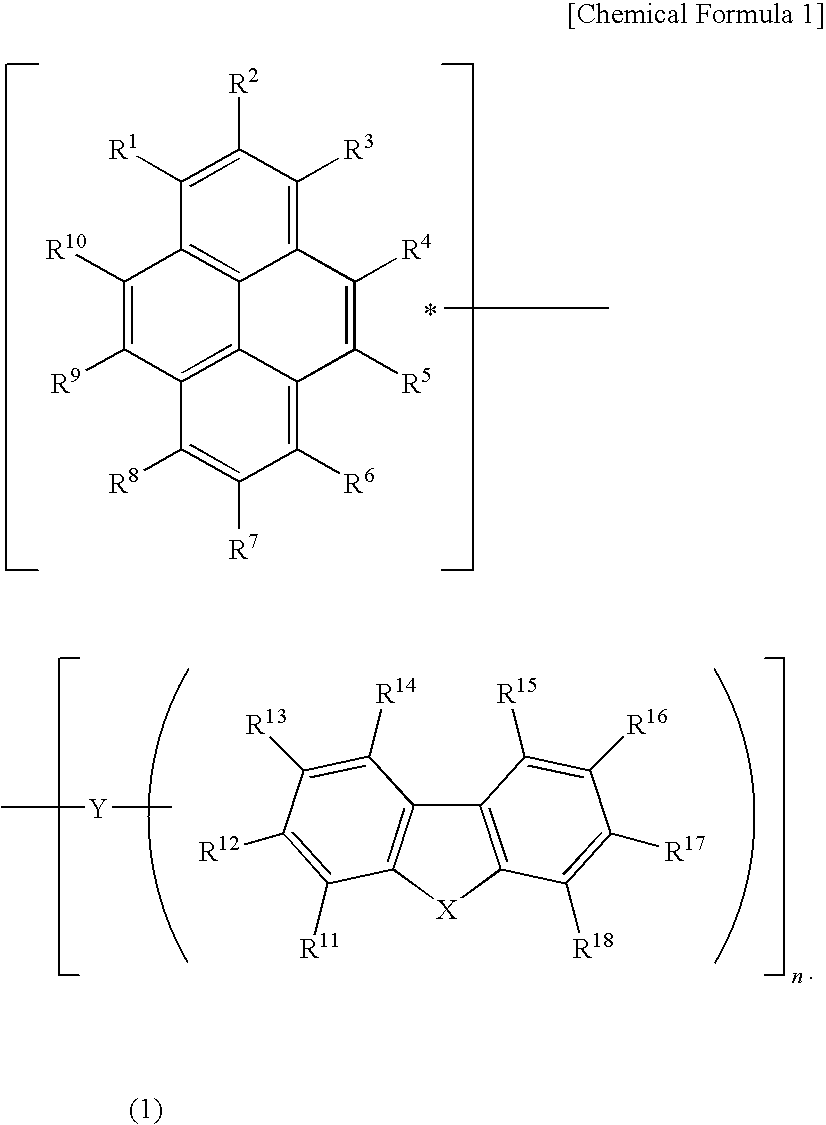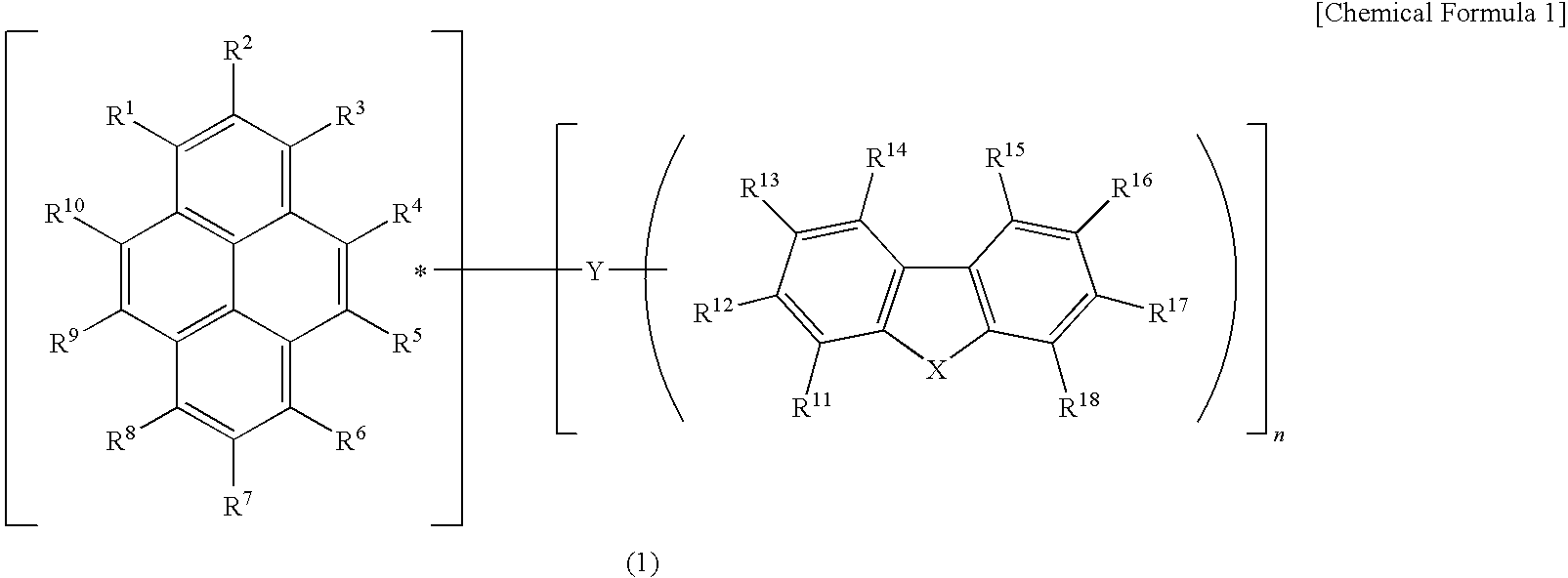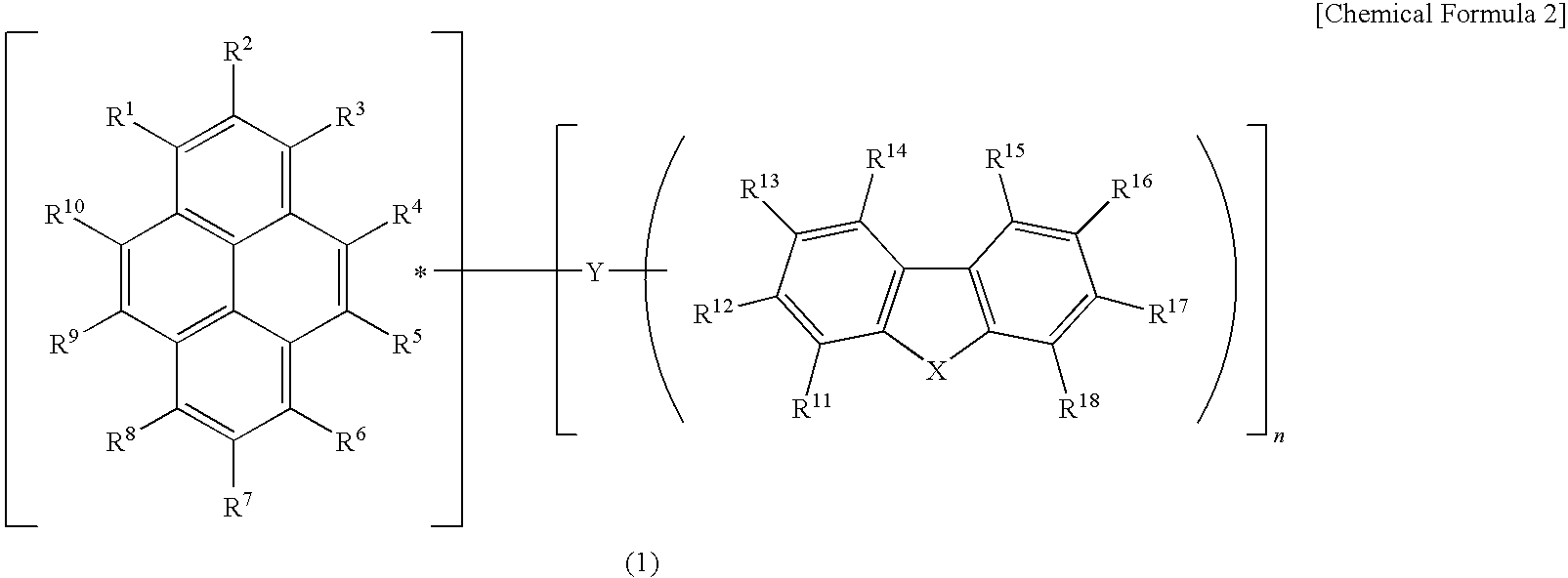Light-emitting device material and light-emitting device
a technology of light-emitting devices and materials, which is applied in the direction of organic semiconductor devices, discharge tubes luminescnet screens, organic chemistry, etc., can solve the problems of insufficient durability of blue light-emitting devices, and achieve excellent thin-film stability, excellent durability, and high luminance efficiency
- Summary
- Abstract
- Description
- Claims
- Application Information
AI Technical Summary
Benefits of technology
Problems solved by technology
Method used
Image
Examples
example 1
Synthesis of Compound [30]
[0072]A mixed solution of 2 g of 1,6-dibromopyrene, 1 g of 4-t-butylphenylboronic acid, 2.4 g of tripotassium phosphate, 0.4 g of tetrabutylammonium bromide, 22 mg of palladium acetate and 60 ml of dimethylformamide was heated and stirred under a nitrogen gas stream at 130° C. for 6 hours. The solution was cooled to room temperature and 30 ml of water was poured into the solution, followed by extraction with 100 ml of dichloromethane. The organic layer was washed twice with 50 ml of water, dried over magnesium sulfate and then evaporated. The concentrate was purified by silica gel column chromatography and then vacuum-dried to obtain 0.7 g of 1-bromo-6-(4-t-butylphenyl)pyrene.
[0073]Next, a mixed solution of 0.7 g of 1-bromo-6-(4-t-butylphenyl)pyrene, 0.74 g of 9-[4-(4,4,5,5-tetramethyl-[1,3,2]dioxaborolan-2-yl)phenyl]carbazole, 0.85 g of tripotassium phosphate, 0.13 g of tetrabutylammonium bromide, 8.0 mg of palladium acetate and 20 ml of dimethylformamide ...
example 2
Synthesis of Compound [69]
[0076]A mixed solution of 45.0 g of 1-bromopyrene, 21.7 g of 4-methylphenylboronic acid, 34.0 g of tripotassium phosphate, 10.3 g of tetrabutylammonium bromide, 0.71 g of palladium acetate and 1.6 L of dimethylformamide was heated and stirred under a nitrogen gas stream at 120° C. for 5 hours. The solution was cooled to room temperature and 1.6 L of water was poured into the solution, followed by stirring at room temperature for 0.5 hours. The precipitated solid was collected by filtration and then washed twice with 200 ml of water. The resulting solid was dissolved in 500 ml of dichloromethane, dried over magnesium sulfate and then filtered through Celite. The filtrate was evaporated and the residue was washed twice with 200 ml of methanol, and then the precipitated solid was collected by filtration and vacuum-dried to obtain 40.0 g of 1-(4-methylphenyl)pyrene.
[0077]Next, a mixed solution of 40.0 g of 1-(4-methylphenyl)pyrene, 24.4 g of N-bromosuccinimide ...
example 3
Synthesis of Compound [47]
[0081]A mixed solution of 59 g of 1-bromopyrene, 40 g of p-chlorophenylboronic acid, 108 g of tripotassium phosphate, g of tetrabutylammonium bromide, 1.15 g of palladium acetate and 1,250 ml of dimethylformamide was heated and stirred under a nitrogen gas stream at 130° C. for 3 hours. The solution was cooled to room temperature and 1,000 ml of water was poured into the solution, followed by filtration. The resulting solid was washed with 200 ml of methanol, dissolved in 1,000 ml of dichloromethane, dried over magnesium sulfate, filtered through Celite and then evaporated. The resulting solid was washed with 200 ml of methanol and then vacuum-dried to obtain 58.2 g of 1-(4-chlorophenyl)pyrene.
[0082]Next, a mixed solution of 58.2 g of 1-(4-chlorophenyl)pyrene, 36.4 g of N-bromosuccinimide and 1,900 ml of dimethylformamide was heated and stirred under a nitrogen gas stream at 40° C. for 6 hours. The solution was cooled to room temperature and 500 ml of water...
PUM
| Property | Measurement | Unit |
|---|---|---|
| Time | aaaaa | aaaaa |
| Time | aaaaa | aaaaa |
| Time | aaaaa | aaaaa |
Abstract
Description
Claims
Application Information
 Login to View More
Login to View More - R&D
- Intellectual Property
- Life Sciences
- Materials
- Tech Scout
- Unparalleled Data Quality
- Higher Quality Content
- 60% Fewer Hallucinations
Browse by: Latest US Patents, China's latest patents, Technical Efficacy Thesaurus, Application Domain, Technology Topic, Popular Technical Reports.
© 2025 PatSnap. All rights reserved.Legal|Privacy policy|Modern Slavery Act Transparency Statement|Sitemap|About US| Contact US: help@patsnap.com



